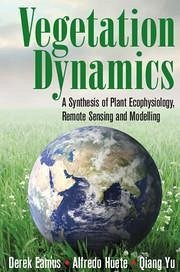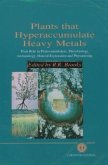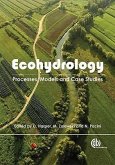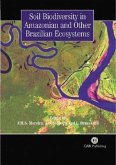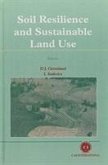Derek Eamus, Alfredo Huete, Qiang Yu
Vegetation Dynamics
A Synthesis of Plant Ecophysiology, Remote Sensing and Modelling
Derek Eamus, Alfredo Huete, Qiang Yu
Vegetation Dynamics
A Synthesis of Plant Ecophysiology, Remote Sensing and Modelling
- Gebundenes Buch
- Merkliste
- Auf die Merkliste
- Bewerten Bewerten
- Teilen
- Produkt teilen
- Produkterinnerung
- Produkterinnerung
Brings together plant ecophysiology, remote sensing and modelling of vegetation and landscape function for advanced students and researchers.
Andere Kunden interessierten sich auch für
![Functions of Natural Organic Matter in Changing Environment Functions of Natural Organic Matter in Changing Environment]() Functions of Natural Organic Matter in Changing Environment308,99 €
Functions of Natural Organic Matter in Changing Environment308,99 €![Plants That Hyperaccumulate Heavy Metals Plants That Hyperaccumulate Heavy Metals]() Robert R BrooksPlants That Hyperaccumulate Heavy Metals241,99 €
Robert R BrooksPlants That Hyperaccumulate Heavy Metals241,99 €![Ecohydrology Ecohydrology]() Iwona WagnerEcohydrology205,99 €
Iwona WagnerEcohydrology205,99 €![Lichens of Licking County, Ohio Lichens of Licking County, Ohio]() J O B FisherLichens of Licking County, Ohio25,99 €
J O B FisherLichens of Licking County, Ohio25,99 €![Modelling Soil-Biosphere Interactions Modelling Soil-Biosphere Interactions]() Christoph MüllerModelling Soil-Biosphere Interactions209,99 €
Christoph MüllerModelling Soil-Biosphere Interactions209,99 €![Soil Biodiversity in Amazonian and Other Brazilian Ecosystems Soil Biodiversity in Amazonian and Other Brazilian Ecosystems]() Soil Biodiversity in Amazonian and Other Brazilian Ecosystems183,99 €
Soil Biodiversity in Amazonian and Other Brazilian Ecosystems183,99 €![Soil Resilience and Sustainable Land Use Soil Resilience and Sustainable Land Use]() D GreenlandSoil Resilience and Sustainable Land Use221,99 €
D GreenlandSoil Resilience and Sustainable Land Use221,99 €-
-
-
Brings together plant ecophysiology, remote sensing and modelling of vegetation and landscape function for advanced students and researchers.
Produktdetails
- Produktdetails
- Verlag: Cambridge University Press
- Seitenzahl: 600
- Erscheinungstermin: 31. März 2016
- Englisch
- Abmessung: 261mm x 184mm x 30mm
- Gewicht: 1257g
- ISBN-13: 9781107054202
- ISBN-10: 1107054206
- Artikelnr.: 43857458
- Herstellerkennzeichnung
- Libri GmbH
- Europaallee 1
- 36244 Bad Hersfeld
- gpsr@libri.de
- Verlag: Cambridge University Press
- Seitenzahl: 600
- Erscheinungstermin: 31. März 2016
- Englisch
- Abmessung: 261mm x 184mm x 30mm
- Gewicht: 1257g
- ISBN-13: 9781107054202
- ISBN-10: 1107054206
- Artikelnr.: 43857458
- Herstellerkennzeichnung
- Libri GmbH
- Europaallee 1
- 36244 Bad Hersfeld
- gpsr@libri.de
Professor Derek Eamus is a professor in the School of Life Sciences, University of Technology, Sydney. He is an internationally recognised plant ecophysiologist and ecohydrologist. He specialises in measuring plant water relations, stomatal behaviour, the carbon and water balances of native woodlands and forests and forging of cross-disciplinary links between our understanding of processes at cellular, whole plant and canopy scales. He has worked extensively in north Australian mesic savannas, arid-zone central Australia and temperate mesic forests, including a range of groundwater dependent ecosystems. He has published more than 185 research publications in diverse journals, including Nature, Nature Climate Change, Remote Sensing of Environment, the Journal of Hydrology, Tree Physiology, Global Change Biology and Agricultural and Forest Meteorology. In 2010 he was awarded the inaugural Chancellor's Medal for Research Leadership and simultaneously, the inaugural Vice-Chancellor's Medal for Research Excellence, from the University of Technology, Sydney. He is the author of Ecohydrology: Water and Resource Management (2006), which provided the first integrative text on hydrology, ecophysiology and ecology of Australian landscapes.
Preface
Part I. Plant Ecophysiology: 1. An introduction to biogeography: broad-scale relationships amongst climate, vegetation distribution and vegetation attributes
2. An introduction to plant structure and ecophysiology
3. Water relations, hydraulic architecture and transpiration by plants
Part II. Remote Sensing: 4. Remote sensing: introduction and overview
5. Fundamentals and physical principles of remote sensing
6. Satellite sensors and platforms
7. Remote sensing of landscape biophysical properties
Part III. Modelling: 8. An introduction to modelling in plant ecophysiology
9. Modelling radiation exchange of leaves and canopies
10. Modelling leaf and canopy photosynthesis
11. Modelling stomatal conductance
12. Modelling leaf and canopy water fluxes and the SPAC
13. Coupling models of photosynthesis, transpiration, stomatal conductance and environmental controls of fluxes
Part IV. Case Studies: 14. Boreal forests
15. Arid and semi-arid grasslands
16. Case study: savannas
17. Seasonal behaviour of vegetation of the Amazon Basin
18. Case study: tropical montane forests
19. Groundwater dependent ecosystems
20. Global change drought and forest mortality
Index.
Part I. Plant Ecophysiology: 1. An introduction to biogeography: broad-scale relationships amongst climate, vegetation distribution and vegetation attributes
2. An introduction to plant structure and ecophysiology
3. Water relations, hydraulic architecture and transpiration by plants
Part II. Remote Sensing: 4. Remote sensing: introduction and overview
5. Fundamentals and physical principles of remote sensing
6. Satellite sensors and platforms
7. Remote sensing of landscape biophysical properties
Part III. Modelling: 8. An introduction to modelling in plant ecophysiology
9. Modelling radiation exchange of leaves and canopies
10. Modelling leaf and canopy photosynthesis
11. Modelling stomatal conductance
12. Modelling leaf and canopy water fluxes and the SPAC
13. Coupling models of photosynthesis, transpiration, stomatal conductance and environmental controls of fluxes
Part IV. Case Studies: 14. Boreal forests
15. Arid and semi-arid grasslands
16. Case study: savannas
17. Seasonal behaviour of vegetation of the Amazon Basin
18. Case study: tropical montane forests
19. Groundwater dependent ecosystems
20. Global change drought and forest mortality
Index.
Preface
Part I. Plant Ecophysiology: 1. An introduction to biogeography: broad-scale relationships amongst climate, vegetation distribution and vegetation attributes
2. An introduction to plant structure and ecophysiology
3. Water relations, hydraulic architecture and transpiration by plants
Part II. Remote Sensing: 4. Remote sensing: introduction and overview
5. Fundamentals and physical principles of remote sensing
6. Satellite sensors and platforms
7. Remote sensing of landscape biophysical properties
Part III. Modelling: 8. An introduction to modelling in plant ecophysiology
9. Modelling radiation exchange of leaves and canopies
10. Modelling leaf and canopy photosynthesis
11. Modelling stomatal conductance
12. Modelling leaf and canopy water fluxes and the SPAC
13. Coupling models of photosynthesis, transpiration, stomatal conductance and environmental controls of fluxes
Part IV. Case Studies: 14. Boreal forests
15. Arid and semi-arid grasslands
16. Case study: savannas
17. Seasonal behaviour of vegetation of the Amazon Basin
18. Case study: tropical montane forests
19. Groundwater dependent ecosystems
20. Global change drought and forest mortality
Index.
Part I. Plant Ecophysiology: 1. An introduction to biogeography: broad-scale relationships amongst climate, vegetation distribution and vegetation attributes
2. An introduction to plant structure and ecophysiology
3. Water relations, hydraulic architecture and transpiration by plants
Part II. Remote Sensing: 4. Remote sensing: introduction and overview
5. Fundamentals and physical principles of remote sensing
6. Satellite sensors and platforms
7. Remote sensing of landscape biophysical properties
Part III. Modelling: 8. An introduction to modelling in plant ecophysiology
9. Modelling radiation exchange of leaves and canopies
10. Modelling leaf and canopy photosynthesis
11. Modelling stomatal conductance
12. Modelling leaf and canopy water fluxes and the SPAC
13. Coupling models of photosynthesis, transpiration, stomatal conductance and environmental controls of fluxes
Part IV. Case Studies: 14. Boreal forests
15. Arid and semi-arid grasslands
16. Case study: savannas
17. Seasonal behaviour of vegetation of the Amazon Basin
18. Case study: tropical montane forests
19. Groundwater dependent ecosystems
20. Global change drought and forest mortality
Index.

